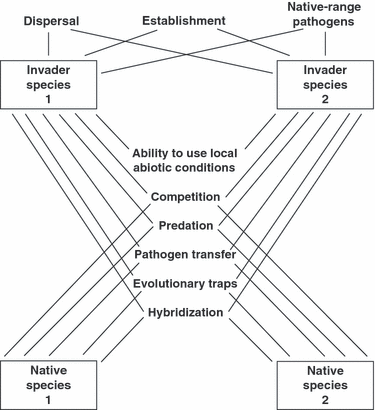Invasive species as drivers of evolutionary change: cane toads in tropical Australia
- PMID: 25568034
- PMCID: PMC3353345
- DOI: 10.1111/j.1752-4571.2011.00201.x
Invasive species as drivers of evolutionary change: cane toads in tropical Australia
Abstract
The arrival of an invasive species can have wide-ranging ecological impacts on native taxa, inducing rapid evolutionary responses in ways that either reduce the invader's impact or exploit the novel opportunity that it provides. The invasion process itself can cause substantial evolutionary shifts in traits that influence the invader's dispersal rate (via both adaptive and non-adaptive mechanisms) and its ability to establish new populations. I briefly review the nature of evolutionary changes likely to be set in train by a biological invasion, with special emphasis on recent results from my own research group on the invasion of cane toads (Rhinella marina) through tropical Australia. The toads' invasion has caused evolutionary changes both in the toads and in native taxa. Many of those changes are adaptive, but others may result from non-adaptive evolutionary processes: for example, the evolved acceleration in toad dispersal rates may be due to spatial sorting of dispersal-enhancing genes, rather than fitness advantages to faster-dispersing individuals. Managers need to incorporate evolutionary dynamics into their conservation planning, because biological invasions can affect both the rates and the trajectories of evolutionary change.
Keywords: adaptation; alien species; ecological impact; spatial sorting.
Figures



Similar articles
-
Is the behavioural divergence between range-core and range-edge populations of cane toads (Rhinella marina) due to evolutionary change or developmental plasticity?R Soc Open Sci. 2017 Oct 25;4(10):170789. doi: 10.1098/rsos.170789. eCollection 2017 Oct. R Soc Open Sci. 2017. PMID: 29134082 Free PMC article.
-
Is the enhanced dispersal rate seen at invasion fronts a behaviourally plastic response to encountering novel ecological conditions?Biol Lett. 2016 Sep;12(9):20160539. doi: 10.1098/rsbl.2016.0539. Biol Lett. 2016. PMID: 27677818 Free PMC article.
-
The impact of transportation and translocation on dispersal behaviour in the invasive cane toad.Oecologia. 2017 Jun;184(2):411-422. doi: 10.1007/s00442-017-3871-y. Epub 2017 Apr 21. Oecologia. 2017. PMID: 28432445
-
The things they carried: The pathogenic effects of old and new parasites following the intercontinental invasion of the Australian cane toad (Rhinella marina).Int J Parasitol Parasites Wildl. 2016 Dec 29;6(3):375-385. doi: 10.1016/j.ijppaw.2016.12.001. eCollection 2017 Dec. Int J Parasitol Parasites Wildl. 2016. PMID: 30951567 Free PMC article. Review.
-
A genetic perspective on rapid evolution in cane toads (Rhinella marina).Mol Ecol. 2015 May;24(9):2264-76. doi: 10.1111/mec.13184. Epub 2015 Apr 20. Mol Ecol. 2015. PMID: 25894012 Review.
Cited by
-
Invasion of the body snatchers: the role of parasite introduction in host distribution and response to salinity in invaded estuaries.Proc Biol Sci. 2021 Jun 30;288(1953):20210703. doi: 10.1098/rspb.2021.0703. Epub 2021 Jun 23. Proc Biol Sci. 2021. PMID: 34157870 Free PMC article.
-
High genetic diversity, phenotypic plasticity, and invasive potential of a recently introduced calcareous sponge, fast spreading across the Atlanto-Mediterranean basin.Mar Biol. 2016;163:123. doi: 10.1007/s00227-016-2862-6. Epub 2016 Apr 30. Mar Biol. 2016. PMID: 27340292 Free PMC article.
-
Methylation divergence of invasive Ciona ascidians: Significant population structure and local environmental influence.Ecol Evol. 2018 Sep 5;8(20):10272-10287. doi: 10.1002/ece3.4504. eCollection 2018 Oct. Ecol Evol. 2018. PMID: 30397465 Free PMC article.
-
The impact of invasive cane toads on native wildlife in southern Australia.Ecol Evol. 2015 Aug 24;5(18):3879-94. doi: 10.1002/ece3.1657. eCollection 2015 Sep. Ecol Evol. 2015. PMID: 26445649 Free PMC article.
-
Sexual selection reinforces a higher flight endurance in urban damselflies.Evol Appl. 2017 May 11;10(7):694-703. doi: 10.1111/eva.12485. eCollection 2017 Aug. Evol Appl. 2017. PMID: 28717389 Free PMC article.
References
-
- Alford RA, Brown GP, Schwarzkopf L, Phillips BL, Shine R. Comparisons through time and space suggest rapid evolution of dispersal behaviour in an invasive species. Wildlife Research. 2009;36:23–28.
-
- Ashley MV, Willson MF, Pergams ORW, O'Dowd DJ, Gende SM, Brown SJ. Evolutionarily enlightened management. Biological Conservation. 2003;111:115–123.
-
- Benkman CW, Siepelski AM, Parchman TL. The local introduction of strongly interacting species and the loss of geographic variation in species and species interactions. Molecular Ecology. 2008;17:395–404. - PubMed
-
- Brown AHD, Marshall DR. Evolutionary changes accompanying colonization in plants. In: Scudder GGT, Reveal JL, editors. Evolution Today. Proceedings of the Second International Conference of Systematic and Evolutionary Biology. Pittsburgh, PA: Carnegie-Mellon University; 1981. pp. 351–363.
LinkOut - more resources
Full Text Sources

